No, growing more food does not mean we always need more and more inputs
Lower-income countries do, but many high and middle-income countries have reduced fertilisers, pesticides, labour, and in some cases land, without reducing food production.
Humanity’s ability to produce enough food for 8 billion people is impressive.1 In fact, we could produce enough calories for far more than 8 billion; we just feed a lot of those calories to farm animals, allocate crops to biofuels, and lose a lot of food in our supply chains.2 The extremely dire predictions of widespread famine from the 1970s and 1980s did not come true thanks to huge improvements in crop yields, intensification, and food production.
When I talk about these positive human developments — and suggest that we’re more than capable of feeding another few billion people over the next 50 years — the pushback is often the same: “we might be able to produce more food, but it’ll take more and more inputs”. By inputs, people mean more fertilisers, pesticides, land, and in some cases more human labour.
There is the automatic assumption that in order to get more out, we need to put more in (and that often means more pollution and environmental damage at the same time). This isn’t necessarily the case.
It’s absolutely true that the growth of agriculture has come at a huge environmental cost; I’ve written about this a lot, so I won’t bang on about it again here. But many countries have shown that it’s possible to do more with less: they continue to produce the same or more food with less (not zero) fertilisers, pesticides, land and human hours.
The European Union’s agricultural policies have been very effective in promoting more efficient use of fertilisers. Since 1990, the amount used in many European countries has more than halved.
Perhaps the most surprising example for many is the turnaround in resource use in China. Over the last half-century in particular, China has had to increase food production rapidly to keep up with population growth. That did mean more workers, more land, fertilisers and pesticides. But in the last decade or two, things have reversed; take a look at the chart below.
Fertiliser and pesticide use peaked in the 2010s, and is now firmly in decline. The expansion of agricultural land stopped in the 2000s, and has slightly declined. And there are now fewer people working on farms than there were in the 1960s when China’s population was less than half the size.
Much like the reductions in the European Union, these changes were at least partly driven by policy decisions.
In 2015, China’s government launched its “Zero-Growth Action Plan for Fertilizer”. Excessive subsidies for fertilisers were cut, and replaced with financial support for interventions that helped with efficiency: precision technologies, farmer education, larger, consolidated farms (which tend to use less fertiliser per hectare) and machinery.
There’s the now infamous decade-long study in which more than 21 million (!) smallholder farmers in China managed to cut fertiliser use (by roughly 15-20%) while growing yields through education and enhanced management practices.3
The US Department of Agriculture uses data on agricultural inputs and outputs to examine how these have changed across countries. The chart below shows how each has changed since 1961. Here, “Outputs” is the total dollar value (adjusted for inflation) of agricultural production. If we were to do the same for total calories, protein or another output indicator, I expect the curve would be similar. “Inputs” is the combination of materials such as fertilisers, land, irrigation and labour.
You can see that output has increased steeply, especially since the 1980s. This was initially driven by an increase in inputs, but over the last decade or so, inputs have stopped increasing.
Instead, gains in output have been driven by the third line: productivity. This is measured as the concept of “total factor productivity” which I’ll explain now.
What is “total factor productivity”?
Total factor productivity (TFP) tells us how much of the growth in output is not driven by an increase in inputs. In simple terms, efficiency. If I have a high TFP, then my outputs have increased a lot from little additional input; if TFP is low, then I needed to use a lot more resources, land or human hours. That’s ultimately what we want: to produce lots of food without having to use more (wo)manpower or natural resources.
TFP is not just a concept used in farming but can also be applied in other sectors or to the whole economy. If a country can achieve a much higher GDP with only very small increases in inputs, then its productivity increases.
In agriculture, there are many reasons why TFP could increase:
Better seed varieties that achieve higher yields (reducing land use and labour), and need fewer fertilisers.
Learning how to apply fertilisers more efficiently (this could be done simply through knowledge and education, or technologies such as precision agriculture).
Better fertilisers and pesticides, which means we need to apply less.
Weather conditions could be more favourable, leading to higher yields without changing what we need to put in.
Better farm practices, such as improved timing of planting, crop rotations, or integrated pest management.
Many more examples…
Improvements in productivity in China, or globally as we’ll look at, will have come from a combination of many of these factors. What’s often difficult is directly attributing gains in productivity — especially at a country level, thousands or millions of farmers — to each of these changes.
Improvements in total factor productivity have been the biggest source of growth in food production globally
China is not alone in its productivity growth. Many countries have seen huge gains. In fact, globally, TFP has been the largest driver of the growth in food production in the last few decades.
In the chart below, you can see the USDA’s analysis of the drivers of growth by decade. In green we see the contribution of the TFP. The other colours represent growth in inputs such as land, irrigation, fertilisers and labour.4
In the 1960s, almost all of the growth globally was coming from more inputs per hectare, such as fertilisers, pesticides and human hours. Since then, this contribution has dropped off dramatically, and improvements in productivity — getting more out of less inputs — has become dominant.
Note that this doesn’t mean we’re not increasing any inputs globally. What it means is that improvements in productivity have reduced the amount of additional inputs we need.
As countries get richer, food production is first driven by more inputs, then improved productivity
It’s interesting to look at these trends by level of income. You can see this in the chart below, where countries are categorised by income groups.
If we start on the right-hand side, most of the gains in output in low-income countries have come from increased inputs. As we’ll soon see, a lot of this has been more labour and more land (rather than more fertilisers).
This is also true for lower-middle income countries, although productivity growth has been slightly stronger.
If we move to upper-middle income countries, we see that growth in the 1960s to 1990s (when they were poorer) was mostly about using more inputs, but in the last 30 years, productivity growth has dominated.
You can see that at all of these income levels, increases in output have been extremely strong. It has had to be, to keep up with population growth. But it’s not just about having more mouths to feed. As countries have gotten richer, their populations have moved to more diverse diets, including more high-value crops and animal products, rather than simple staples. This means the monetary value of the output has also increased a lot.
These two reasons at least partly explain why the increase in outputs in high-income countries has been far lower. They have had much slower population growth, and already had relatively diverse diets in the 1960s with lots of meat, dairy, vegetables and fruits.
You can see that nearly all of this increase in output has come from productivity improvements. Agricultural inputs have actually fallen. So it’s not just that productivity has slowed the growth of using more inputs; it has actually put this into reverse.
Low-income countries still need more fertiliser, pesticides and irrigation
From this, some people might conclude that low-income countries don’t need to increase their inputs; they could just focus on productivity instead.
This is not what I’m saying.
Countries like China or the UK have managed to decrease their use of fertilisers or pesticides — and become more efficient at using them — after using them in large quantities. Even the levels they use now — after some significant improvements in efficiency — are far, far higher than fertiliser use in low-income countries such as Nigeria, Malawi, or Kenya. Take a look at the chart below.
It would be incorrect to say that these countries at the bottom can easily increase yields and food production without increasing inputs. By drawing on lessons and technologies from other countries, they can probably go through the “rise-peak-fall” pathway faster, and at a lower peak, than others, but zero growth in important inputs like fertilisers and irrigation seems unlikely.
It’s not unlike many other environmental problems. To expect that countries like Nigeria or Kenya will see absolutely no increase in greenhouse gas emissions over the next few decades is absurd. But to expect that they can follow a “cleaner” development pathway using lower-cost energy technologies and knowledge that the UK or the US didn’t have when they were developing a century ago, seems totally plausible.
You might argue that we don't produce enough to feed 8 billion people because around 800 million people in the world do not get enough calories to eat, and are undernourished.
This is true, but global hunger is not caused by our inability to grow enough — the average calorie supply per person is far higher than what we need. It’s about distribution and allocation, which are still major issues.
Having a nutritious diet is about much more than just calories. Total protein production is also higher than the requirements for 8 billion people.
To ensure that everyone had not only enough complete proteins and micronutrients, we might need to change the distribution of some of the crops we produce (and combine this with processes such as fortification).
Cui, Z., Zhang, H., Chen, X., Zhang, C., Ma, W., Huang, C., ... & Dou, Z. (2018). Pursuing sustainable productivity with millions of smallholder farmers. Nature, 555(7696), 363-366.
Note that here, some of the metrics are given specific weightings and therefore don't represent the "raw" metrics that you might see elsewhere.
The "expansion of agricultural land" in red doesn't represent the total farmland in hectares, but applies a weighting where irrigated croplands are weighted more heavily than rainfed croplands, which are weighted more than pasture. So a country's total land use could be stable or even declining, but this metric suggests an increase if irrigated or rainfed croplands are still expanding.


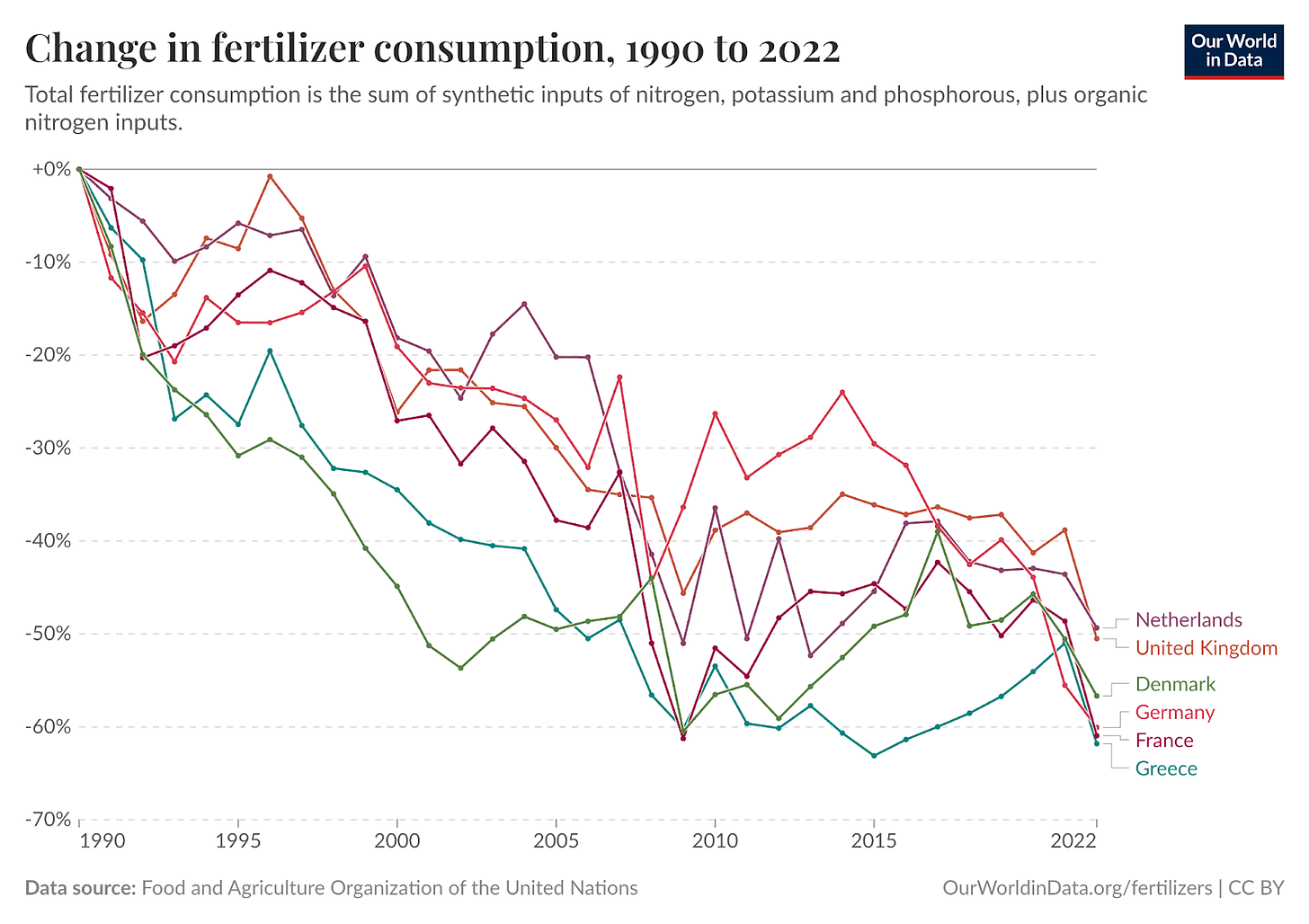
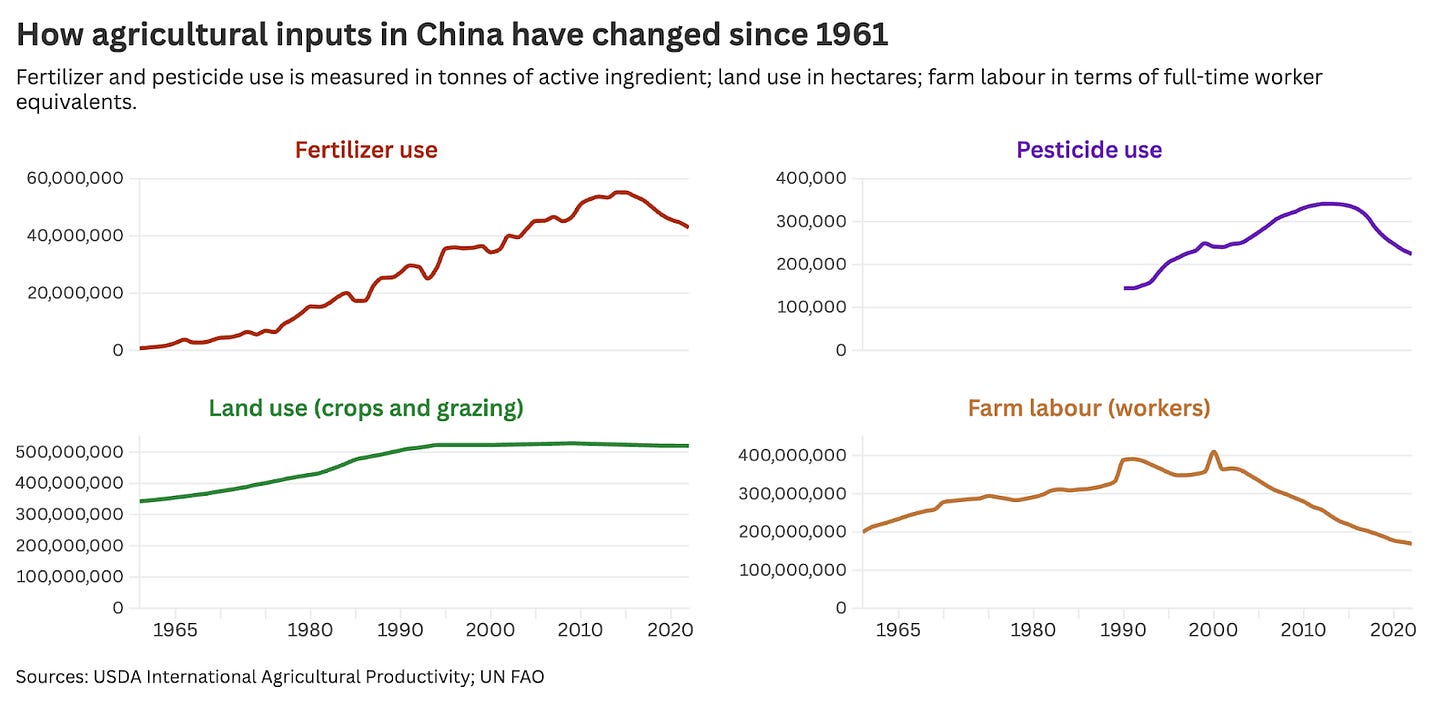
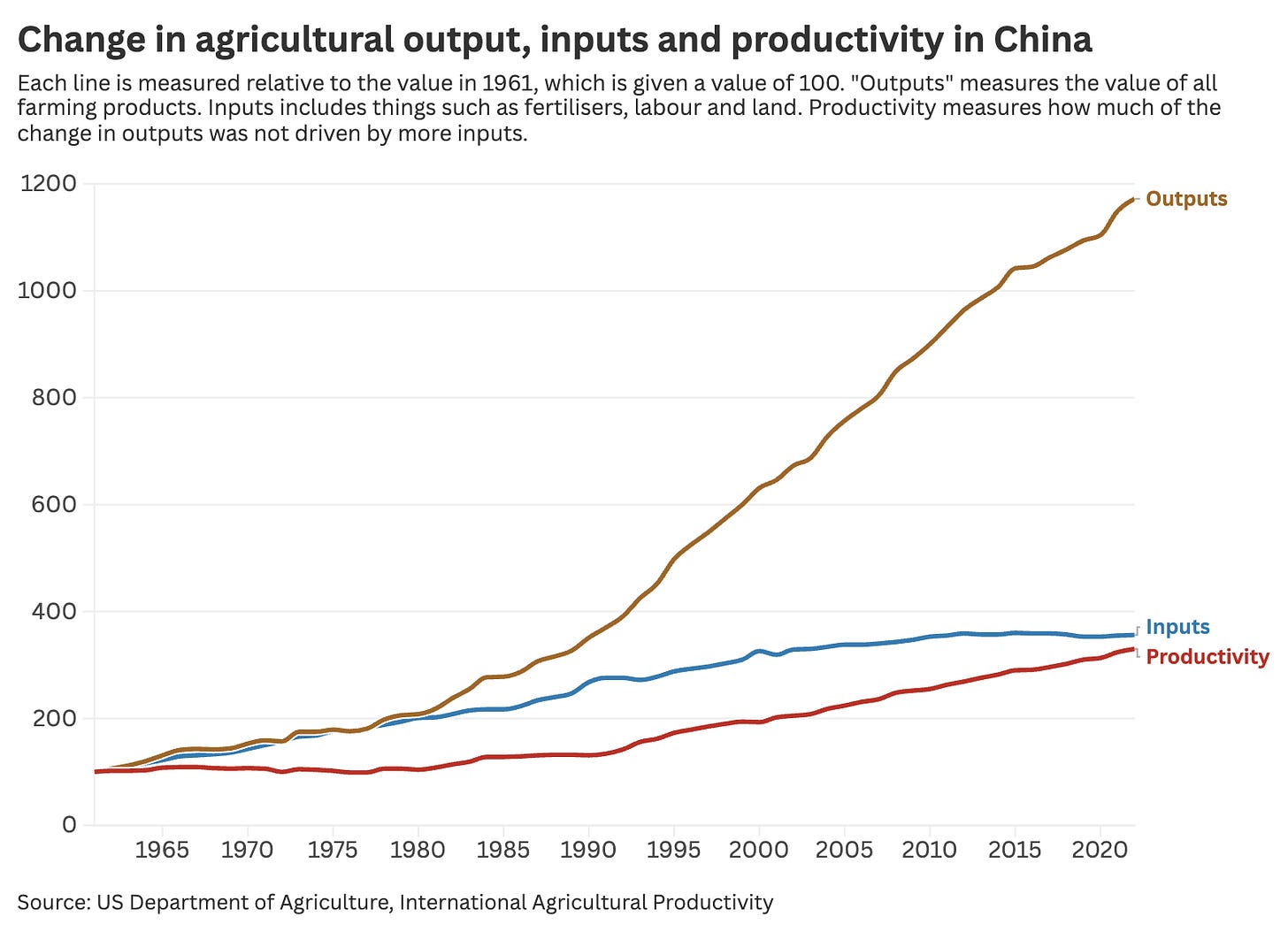
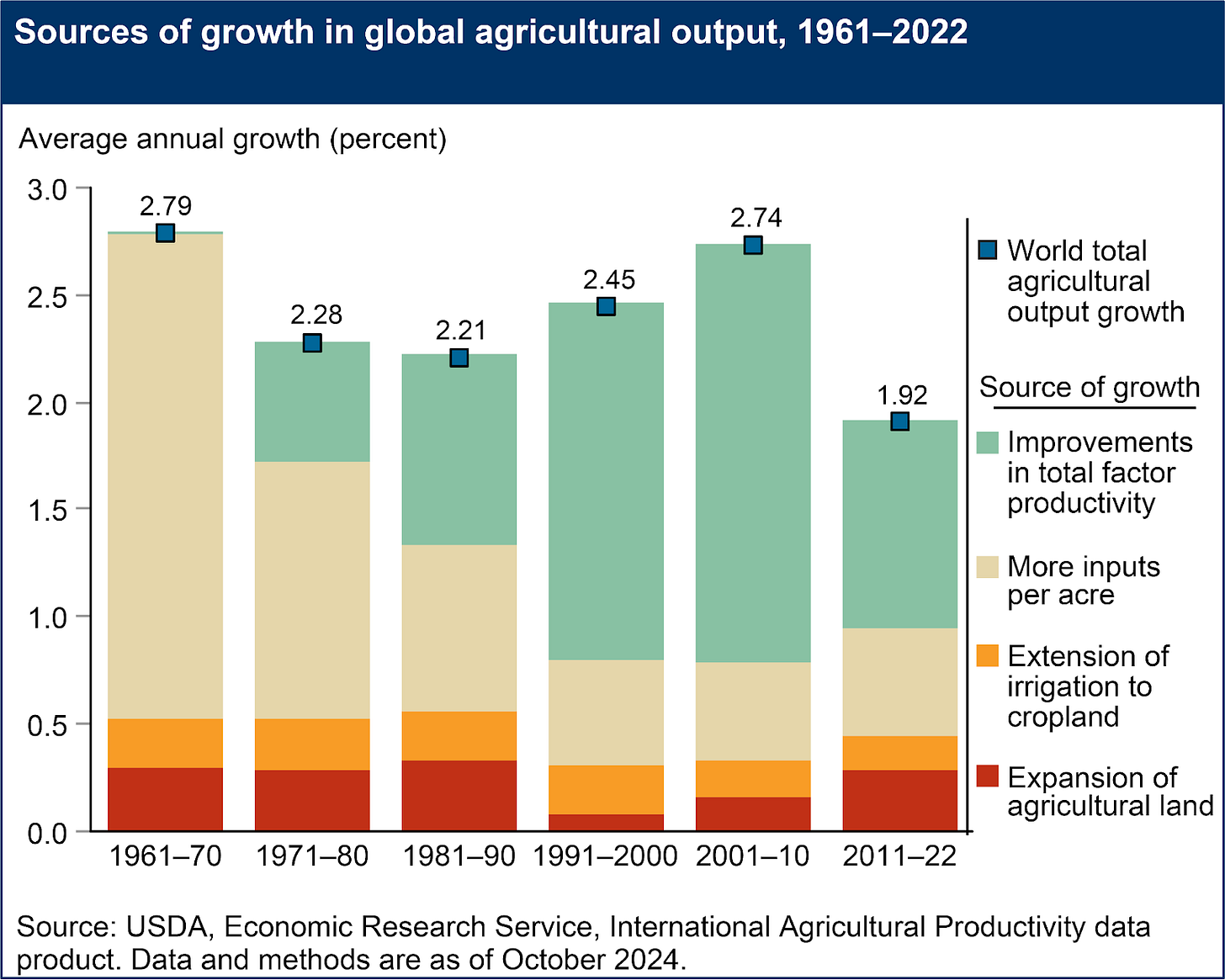
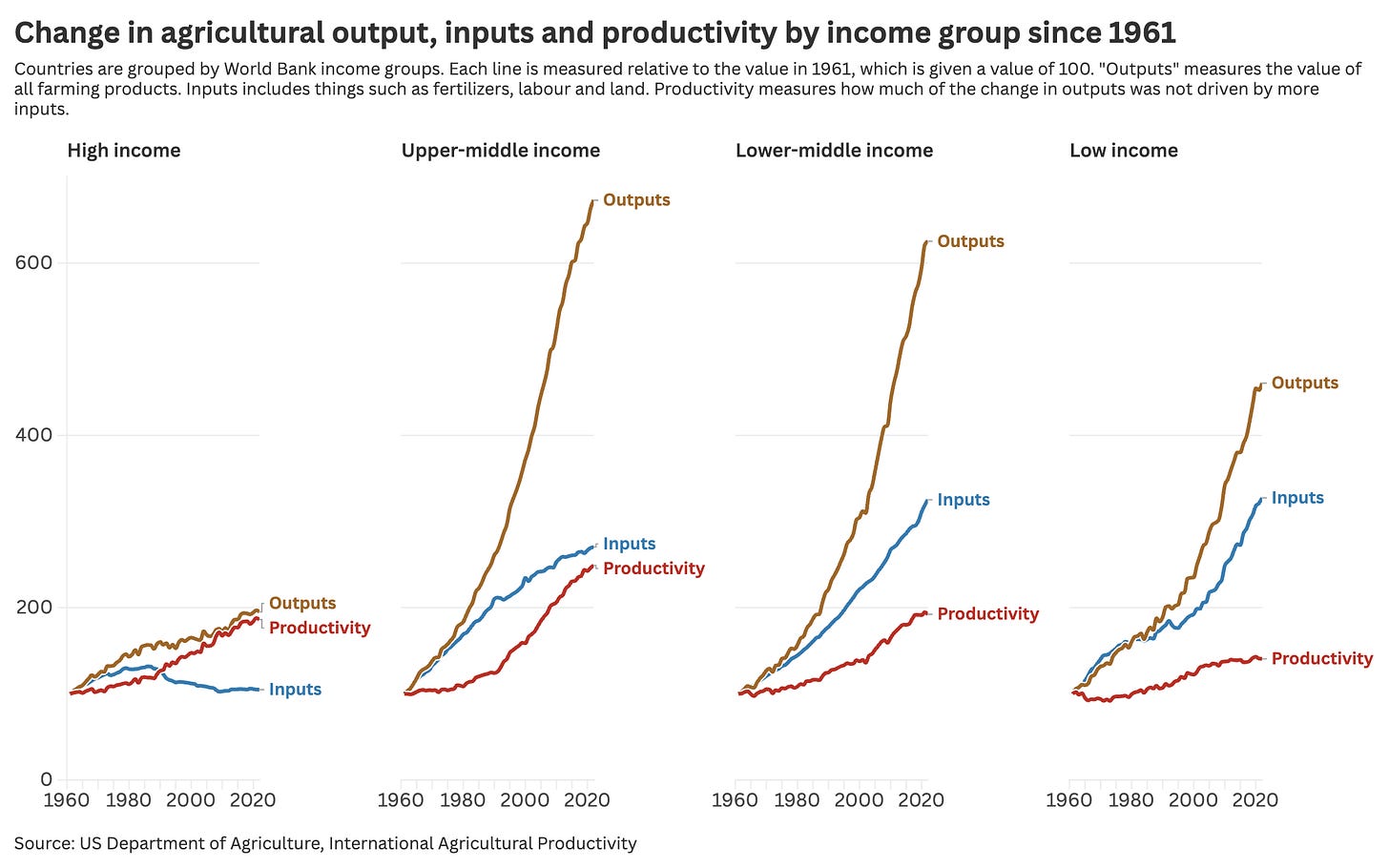
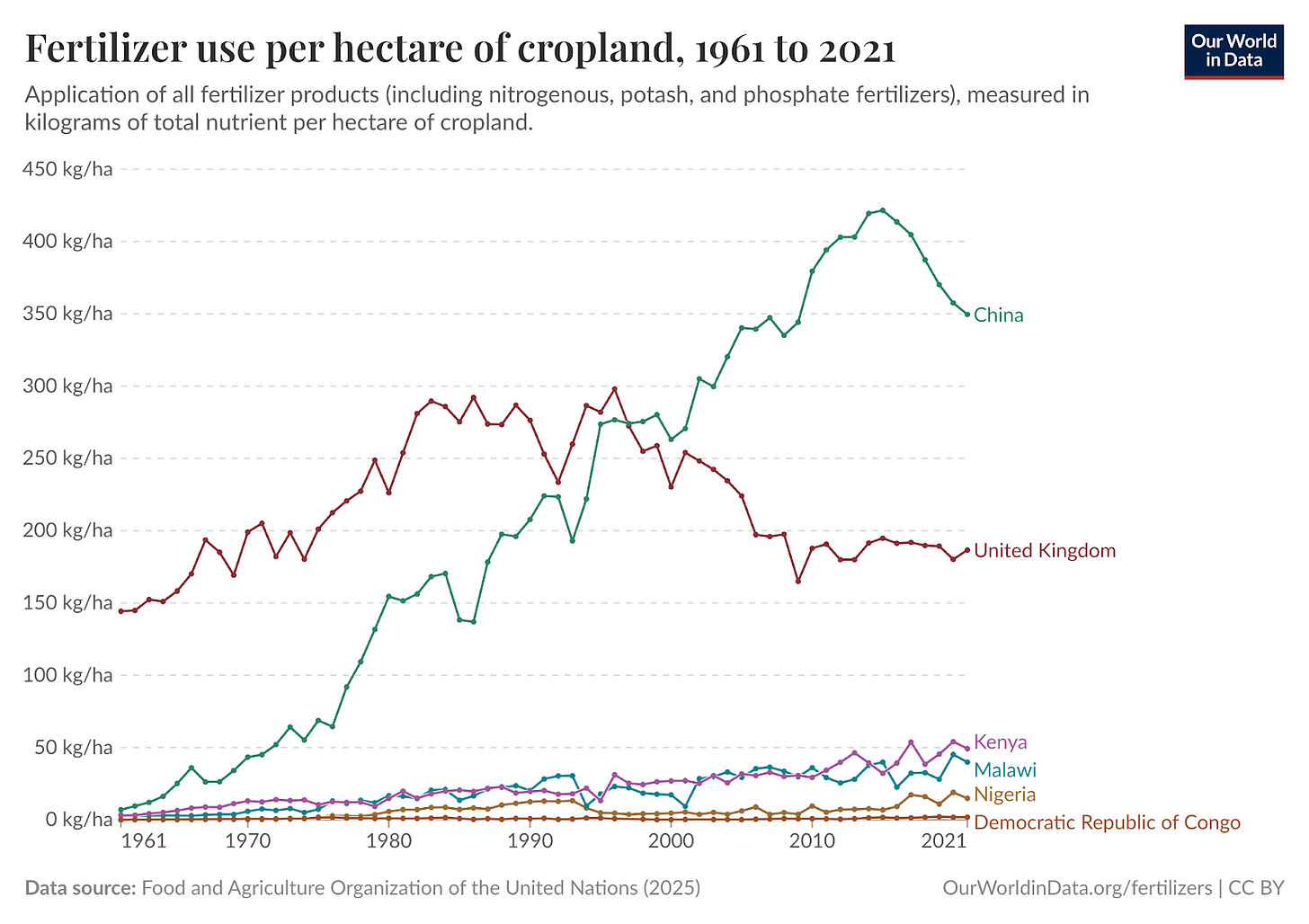
Another amazing and important collection of inconvenient truths.
As always, thanks for pushing back against the Doomer Cult, Hannah.
One factor that you don't really touch on is energy input. Much of the gains have been due to increased mechanisation driving productivity. It has ben a massive benefit, but we may be nearing a peak there. Oil prices are high, and still rising, and at the same time there is a realisation that deep ploughing damages the soil. So far we aren't seeing much penetration of battery power in agriculture, but I can see that it can happen. No-plough techniques open up an opportunity for lighter machines, whilst autonomous tractors can be shrunk that bit more as the cab is removed and the gearboxes and steering rationalised. Already hand-held equipment is switching fast to battery power, as it reduces the weight and the maintenance cost and this change should move up the rest of the farm machinery chain.
The next stage, which is heralded but not yet really here, is using drones to monitor crops and apply targeted treatment. That will be especially applicable to small plots allowing farmers to exploit land that is unsuitable for heavy machines, and being able to manage fields that are simple rectangles. This might be the area where China and developing countries will really have an opportunity to leapfrog the high and middle income economies.